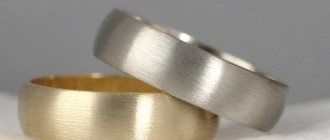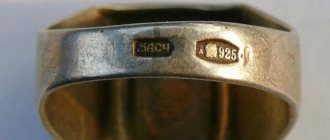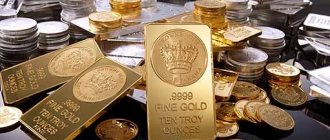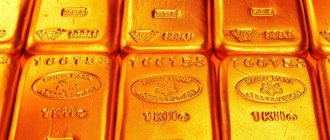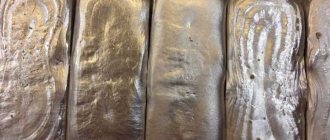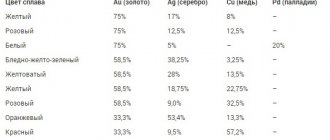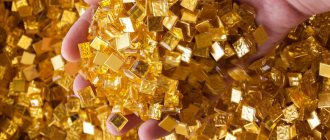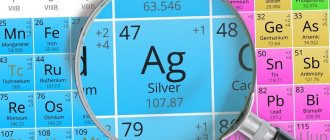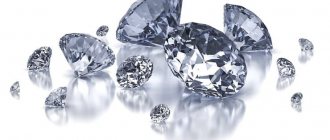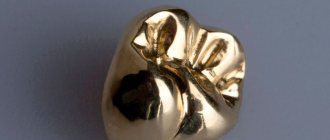Noble metals have been known to people since ancient times. They were used to make jewelry and weapons for high-ranking officials, rulers, and military leaders. Gold is considered a beautiful material with unusual qualities. To expand its applications, jewelers began to create mixtures with the addition of other materials. An alloy of gold and silver is used in various industries.
Alloy of gold and silver
Color of gold and silver alloy according to GOST
One of the main features of electrum is its color spectrum of greenish-yellowish tones. This quality is reflected in regulatory documents such as GOST. Samples used to mark the alloy: 585 (14 carats), 750 (18 carats).
Gold leaf, which consists of thin plates for gilding various objects, architectural structures, such as church domes, has a fineness of 960 (23 carats).
The color of green precious metal according to Gosstandart is described by the following compounds:
585 sample:
- ZlSR 585 -415 – green color, melting point 1025-1030 degrees;
- ZlSrM 585-300 - yellow-green color, melting point 835-880 degrees.
Properties and structure
There has long been a concept that a compound in which silver predominates (more than 70%) is it. The same was said about other components. Electrum occupied a middle position between these metals. Current realities show that it is possible to produce products that contain less than 35% gold. Depending on the content of components in the composition, the properties of elethrum also change:
- belongs to the class of native elements;
- increased resistance to oxidation;
- high melting point;
- density - 6.5 g/cm3;
- Mohs hardness - 3 points.
The properties of the composition are not precisely described. They vary depending on the percentage of mixture components.
Range of alloys of gold with other metals in the jewelry industry
Along with electrum, which combines gold and silver into an alloy, there are a number of compounds that are used to make coins and jewelry. The most common ones are characterized by the following samples:
- 999 – 24-carat, less than 0.1% impurities. It is used primarily for the production of ingots. For other purposes it is of little use due to its increased softness.
- 916 – 22 carats. Used mainly in the east.
- 750 – 18 carats. High quality alloy with 75% gold.
- 585 – 14 carats. The most popular standard, widely used by jewelers.
- 375 – 9 carats. A low-grade precious metal, usually alloyed with copper, so it has a reddish tint. Products made from it are found quite often.
In addition to these samples, there are a number of rarer ones, products with which are used in industrial production. They are not used to create jewelry.
In Tsarist Russia, other samples were used and can be found on antique items made of precious metals. They were marked: 56, 72, 82, 92, 94, 96, measured by spools. This is an ancient measure of weight - 4.27 grams; it corresponded to a weight of the same mass.
Alloys with gold make this metal more wear-resistant and practical
Subtleties of alloy manufacturing
When making an alloy, you need to take into account some features:
- Melting of gold and other noble materials must occur before additional components. This is due to their rapid oxidation in air.
- If you add copper before noble materials, the mixture will harden unevenly, which will negatively affect its further processing and operation.
- The percentage of additional components affects the color of the electrum and its characteristics.
- To prevent the mixture from darkening, you need to take 3 parts gold and 1 additional component.
It is important to control the temperature during melting. This will prevent the metals from burning through.
After production, the craftsman will want to know the sample of the resulting product. To do this, you need to find out its total mass and the weight of individual components. If there is 60 grams of gold, and the product weighs 100, then it can be classified as 585.
Alloy making
The popularity of the alloy of gold and silver in ancient times, in various industries today
Known since ancient times, electrum has found wide application. Due to its unique qualities and unusual color, it has been used in various ways.
Ritual weapons
Weapons for rulers and military leaders of the Ancient world could contain inserts made of an alloy of gold and silver.
In Ancient Egypt, they covered obelisks, the tops of pyramids, the so-called pyramidia.
Weapons of Ancient Egypt Warriors
Valuable jewelry
Products made of unusual whitish and greenish precious metal have been popular since ancient times.
Nobel Prize medals have been molded from 100% electrum for decades.
First minted coins
Archaeologists found the earliest coins in the territory of the Ancient Kingdom of Lydia, Eastern Greece. They were called Lydian coinage after their geographical name. Their use was due to their high hardness and wear resistance, better than that of the base noble metal.
Historical data
Precious alloys of these metals have been known since antiquity. The ancient Greeks gave the compound the name “electrum”, but they began to mine it in ancient Lydia. The silver content could reach 50%. Because of this, the color of the product changed to milky yellow. Therefore, many people call this compound “white gold.”
Technologies make it possible to create a mixture artificially. The composition may consist of 70% silver. The color is similar to the predominant component.
Silver
In our country, such samples are allowed from 800 to 999.
The most practical is 875 sample. This material is a good basis for creating jewelry, which contains 81.5% of this precious metal. The other part is copper, which prevents oxidation. Therefore, silver of this standard is darker than other varieties.
To create items for table setting, 916 grade precious metal is used. To ensure a high level of protection of the silver surface from oxidation, it can be covered with a layer of gold or 999 silver.
Gold
The sample is determined by the proportion of gold in the composition:
- 375 – 38%. Another share is silver, copper and other components. Characteristic color: from characteristic red to yellow.
- 500 – 50,5%.
- 585 – 59% precious metal. Durable and hard, does not fade in air. It is widely used in jewelry.
- 750 – 75.5%. Wide color range. It is well processed, so it is often used to create jewelry.
- 958 – 96.3%. Rarely used in jewelry making. Has a soft color. The cost of metal is high.
- 999 is pure gold, subject to deformation, so it is not used in jewelry.
These samples are applied to the products, so when purchasing you can find out what precious metal the product is made of.
The benefits of gold
Gold jewelry is an excellent gift for friends or relatives and a pleasant purchase for yourself. It can be stored for years and passed from mother to daughter. The gold alloys available on the market today are of high quality. There are people with individual intolerance to certain components, for example, cadmium or zinc, so it is worthwhile to find out about the composition of the alloy before purchasing, so that you do not have to resell the product later. If you have an intolerance to any of the precious metals, you can always do gold plating on the area that comes into contact with the skin, for example, on the stem of the earrings. This simple procedure will allow you to wear any metal jewelry.
Gold alloys are created to provide maximum variety to the jeweler's artistic vision. So, if in many countries only pure gold is priced, in Europe and the CIS the design and relevance of the model are valued. This is why even alloys with low gold content can be very expensive. Buy gold for yourself and your loved ones, or simply admire the beauty of this sunny metal, warming with its golden hue at any time.
Varieties
Native gold has several varieties.
- Electrum (or silver gold).
- Cuproaurite (or auricupride), otherwise called cuprous (pure) gold. Contains, in addition to the yellow metal, a significant percentage of copper. At a copper content of 9-20% the color becomes pinkish, at 25-30% it becomes red. Because of this color, the name of such nuggets came about - red gold.
- Bismuthaurite (or bismuth gold). Contains up to 4% bismuth.
- Will give birth (born gold). Contains up to 43% rhodium.
- Porpecite (palladite gold). Named after the Porpetse region in Brazil, it contains between 5% and 12% palladium. The nugget is white.
- Iridescent gold. Contains up to 30% iridium in pure form or with impurities.
- Platinum gold. This alloy contains up to 11% platinum or a mixture.
- Magnetic gold. Contains iron impurities.
In our country, electrum is mined in the Far East (Khakanja deposit), Aldan, the Urals and Altai, Transbaikalia, the Republic of Sakha (Yakutia) and Primorye.
Electrum deposits
In the modern world, deposits of this alloy are still observed in Turkey, in one of its regions called “Western Anatolia”. Its extraction is more expensive than industrial production. The crystals that the earth threw to the surface have long been collected. In addition, the found alloys may contain an admixture of copper. Modern technologies make it possible to combine gold with many metals, obtaining the required percentage.
Currently, a promising compound used in medicine is an alloy of gold and titanium. It is characterized by increased strength and may be used in dental prosthetics.
Ancient scriptures
The chronology has such a period as millennia BC. Many people know about this time from historical books that describe the reign of the Egyptian pharaohs. Back then, noble people on the street were distinguished from the poor by the fact that the rich wore gold jewelry.
The first nuggets of this mineral were found in East Africa on the banks of the Nile River, where Egypt is also located. Electrum was originally used to make Lydian money, as pure gold is much heavier and more fragile. And this alloy was distinguished by its lightness and wear resistance due to the presence of silver in it. It was also soft enough and amenable to forging, so they also made dishes from it. It did not oxidize, unlike iron, and was often found during excavations of the burial places of the pharaohs. The famous Cleopatra was very fond of jewelry made from this alloy.
In Ancient Egypt, alchemists who studied astrology knew 8 minerals. Among them were gold, silver, iron, copper, tin, lead, emerald and electrum. Therefore, each planet had its own metal assigned. In ancient times, the week began with Sunday, which is ruled by the Sun, and, of course, its element is gold. Monday is ruled by the Moon and holds silver. The iron was given to Mars. Mercury is associated with tin and Venus with copper. Heavy lead is attributed to Saturn.
Jupiter is considered the planet of wealth, so it rightfully received electrum, which combines three minerals at once. This can be learned from the manuscript, which is currently kept in the library of St. Mark, located in Venice.
Application
Alloys of precious metals are used in the jewelry industry , where they are used to make various jewelry, such as rings, chains, pendants and earrings. In dentistry , they are used in the production of bridges and crowns.
In the chemical industry, certain alloys are needed to coat pipes that are used to transport aggressive chemicals. In the electronics industry, there is a need for gold-silver alloys for the manufacture of current-collecting electrodes. In microelectronics, noble metal alloys are used in the form of electroplating of connectors and contact surfaces. They are also used for the manufacture of valuable award paraphernalia in sports (cups, medals). In the nuclear field, it is also impossible to do without precious metals and their mixtures.
Based on these substances, even pharmacological drugs are produced to combat diseases such as tuberculosis or rheumatoid arthritis.
Products made from an alloy of yellow metal will always be in demand , because, in addition to all of the above, they are also a good investment for the future.
Learn more about another popular alloy of precious metals – red gold – in the video below.
Effect of impurities
Among the alloys, which is the name given to the impurities that are used in gold alloys, there are quite traditional, time-tested metals. It is worth mentioning right away that the alloy that is used in Russia for the production of jewelry can only inspire confidence when it is made in accordance with GOST. A special commission studied various tests for their strength, wear resistance, hypoallergenicity and established standards that all official manufacturing companies must comply with. Alloys of 375, 500, 585, 750, 958, 999 samples were approved. The 583 sample was excluded after the collapse of the USSR and replaced by the 585 sample. Any intermediate indicators can only be found in products imported from abroad.
Among the traditional additives of jewelers are silver, cadmium, platinum, copper, palladium, nickel, and zinc. Let's consider the properties that certain components impart to the metal.
Silver is the base version of the ligature for many types of gold. Silver lowers the melting point and makes the alloy more malleable. It also adds strength to the finished product. Its content in the product can range from a very small percentage to 60-65%. First of all, the percentage of content will affect the appearance of the product, namely the color of the metal. The more silver there is, the less yellowness there is in the metal. An alloy with 60 percent or more silver becomes white. While in Russia they prefer the addition of copper, in Europe they mainly use silver, so gold differs from the jewelry houses of European capitals in its characteristic light lemon tint.
Copper is an attribute of Soviet gold. And now its use as a ligature is widespread. It gives hardness and a reddish tint to gold alloys. Often, in addition to copper, at least 5% silver is added, since its high content reduces the anti-corrosion properties of the alloy. The alloy, beloved by residents of the CIS, however, is not respected in many countries, for example, in the UAE such gold is simply considered to be of poor quality.
Platinum is an expensive metal, so its addition affects the cost of the product. It supports gold in the fight against corrosion and gives the metal its whiteness. Its percentage is usually small, because to increase the elasticity of the alloy and its white color, less than 10% of the total mass of platinum is needed.
Palladium is a fairly rare alloy for gold alloys. Its advantage is to increase the melting point of gold and impart a white color. The palladium content can be about 10%, and this is already enough to change the color. It is rarely used as it is a refractory metal and difficult to work with.
Zinc is an alloy that changes the color of gold, giving it a green tint. In addition, it lowers the melting point and makes the alloy more fluid. Too high a percentage of zinc content can lead to brittleness of the alloy, but this option is acceptable for those elements of jewelry that are used as a decorative insert.
Appearance of zinc.
Cadmium is an element that is usually added in very small quantities. It can affect the color of the alloy, making it pale yellow or even gray, or it can only add special properties - lower the melting point.
Nickel is an alloy that makes the metal harder, allowing you to work with it more creatively, without worrying about the model’s resistance to pressure and shock. It practically does not change the color, only making the shade of yellow a little paler.
Alloys of gold with tin, lead, bismuth, and antimony are also acceptable, but they are not suitable for jewelry as they make the metal more fragile. Ruthenium, iridium and osmium can be added to strengthen the alloy, but they do not affect its color in any way.
